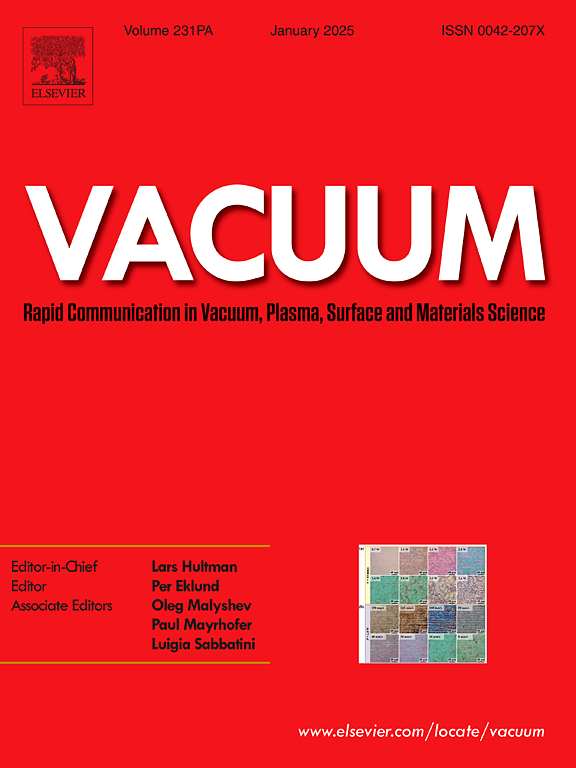Surface patterns shaped by additives in crystals
IF 3.9
2区 材料科学
Q2 MATERIALS SCIENCE, MULTIDISCIPLINARY
引用次数: 0
Abstract
One technique for creating semiconductor crystals with new, desired properties involves replacing some atoms in the crystal lattice with additives — atoms of a different type. This substitution not only alters the bulk properties of the crystal but also affects the patterns formed on its surface. A surface that is smooth and regular in a uniform crystal can become bunched or meandered under the same growth conditions if some atoms are replaced by additives. The Vicinal Cellular Automaton (VicCA) model is used to study this behavior, analyzing the mechanism of pattern formation when additives are introduced into the system. It has also been shown that the newly formed structures resulting from the presence of additives can be smoothed by applying successive layers of a homogeneous composition on top for a sufficiently long time. Additives can also act as smoothing agents for bunched or meandered surface patterns that develop in a homogeneous crystal. However, their effectiveness diminishes for spatially extended patterns such as nanowires (NWs). Typically, when homogeneous crystal layers are applied to spatial structures, the resulting surface is not entirely smoothed but instead transforms into a distinct shape. This phenomenon is demonstrated, and its underlying mechanism is thoroughly analyzed.

晶体中添加剂形成的表面图案
制造具有新特性的半导体晶体的一种技术是用添加剂——一种不同类型的原子——取代晶格中的一些原子。这种取代不仅改变了晶体的体积性质,而且还影响了其表面形成的图案。在相同的生长条件下,如果用添加剂取代某些原子,均匀晶体中光滑而规则的表面就会变成束状或弯曲状。采用邻域元胞自动机(VicCA)模型对该行为进行了研究,分析了添加物进入系统后图案形成的机理。还表明,由于添加剂的存在而产生的新形成的结构可以通过在顶部连续施加均匀组合物的层足够长的时间来平滑。添加剂也可以作为平滑剂,在均匀晶体中形成束状或弯曲的表面图案。然而,对于空间扩展的模式,如纳米线(NWs),它们的有效性会降低。通常,当均匀晶体层应用于空间结构时,得到的表面并不是完全光滑的,而是转变成一个独特的形状。论证了这一现象,并深入分析了其潜在机制。
本文章由计算机程序翻译,如有差异,请以英文原文为准。
求助全文
约1分钟内获得全文
求助全文
来源期刊

Vacuum
工程技术-材料科学:综合
CiteScore
6.80
自引率
17.50%
发文量
0
审稿时长
34 days
期刊介绍:
Vacuum is an international rapid publications journal with a focus on short communication. All papers are peer-reviewed, with the review process for short communication geared towards very fast turnaround times. The journal also published full research papers, thematic issues and selected papers from leading conferences.
A report in Vacuum should represent a major advance in an area that involves a controlled environment at pressures of one atmosphere or below.
The scope of the journal includes:
1. Vacuum; original developments in vacuum pumping and instrumentation, vacuum measurement, vacuum gas dynamics, gas-surface interactions, surface treatment for UHV applications and low outgassing, vacuum melting, sintering, and vacuum metrology. Technology and solutions for large-scale facilities (e.g., particle accelerators and fusion devices). New instrumentation ( e.g., detectors and electron microscopes).
2. Plasma science; advances in PVD, CVD, plasma-assisted CVD, ion sources, deposition processes and analysis.
3. Surface science; surface engineering, surface chemistry, surface analysis, crystal growth, ion-surface interactions and etching, nanometer-scale processing, surface modification.
4. Materials science; novel functional or structural materials. Metals, ceramics, and polymers. Experiments, simulations, and modelling for understanding structure-property relationships. Thin films and coatings. Nanostructures and ion implantation.
 求助内容:
求助内容: 应助结果提醒方式:
应助结果提醒方式:


